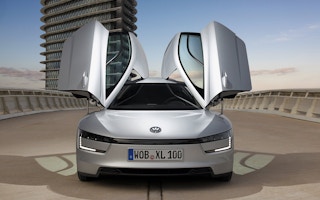Today the Volkswagen XL1 makes its U.S. debut at the 23rd Annual Society of Environmental Journalists (SEJ) Conference at the Chattanooga Convention Center.
The XL1, known as the most fuel-efficient and aerodynamic production car in the world, returns an estimated European combined fuel consumption rating of 261 mpg (more than 200 mpg estimated in the U.S. cycle) and can cover up to 32 miles as a zero-emissions vehicle in all-electric mode.
“The XL1 offers a glimpse into Volkswagen’s present and future eco-mobility capabilities, and highlights the ultimate successes of ‘Thinking Blue’,” said Oliver Schmidt, General Manager of the Engineering and Environmental Office (EEO), Volkswagen Group of America, Inc. “Volkswagen is proud to debut this ultra-fuel-efficient vehicle before the Society of Environmental Journalists, a group that shares in our commitment to environmental stewardship.”
In addition to the XL1 display, Volkswagen’s participation in the SEJ Conference included a tour of its LEED Platinum-certified Chattanooga manufacturing plant and solar park; test-drives in its line of eco-friendly cars, such as the e-Golf, Passat TDI Clean Diesel and Jetta Hybrid; and a bird-watching expedition on Volkswagen Chattanooga’s sanctuary grounds.
VW said the XL1 follows pure sports-car design principles: light weight (1753 pounds), exceptional aerodynamics (Cd 0.19), and a low center of gravity. This super-efficient Volkswagen has the ability to cruise down the road at a constant 62 mph while using just 6.2 kilowatt. In all-electric mode, the XL1 requires less than 0.1 kilowatt-hour to cover more than a kilometer.
According to VW, conceptually, the XL1 represents the third evolutionary stage of Volkswagen’s 1-liter car strategy. When the new millennium was ushered in, Prof. Dr. Ferdinand Piëch, now Chairman of the Supervisory Board of Volkswagen AG, formulated the visionary goal of putting into production a practical car that had combined fuel consumption of one liter per 100 kilometers (235 mpg).

















